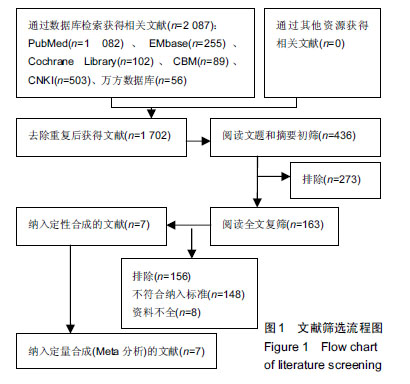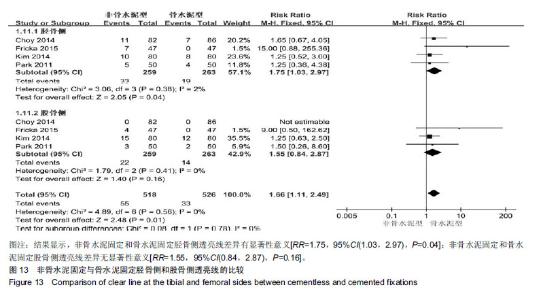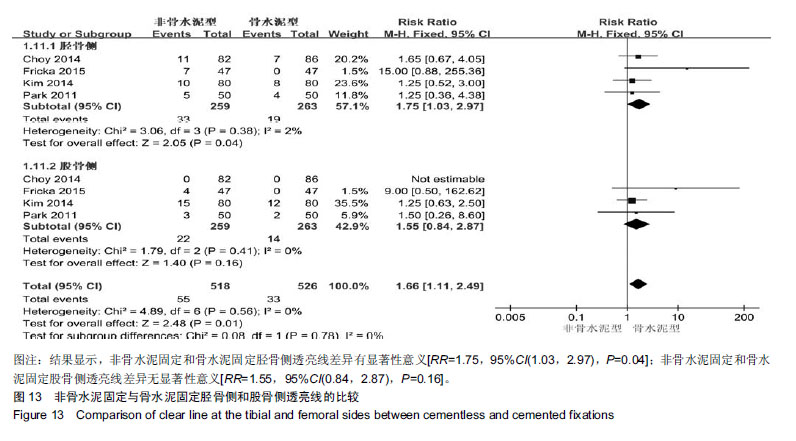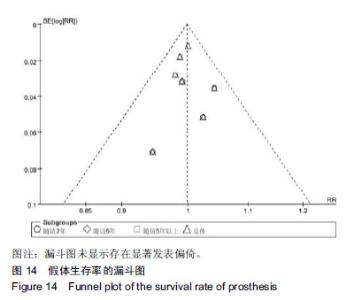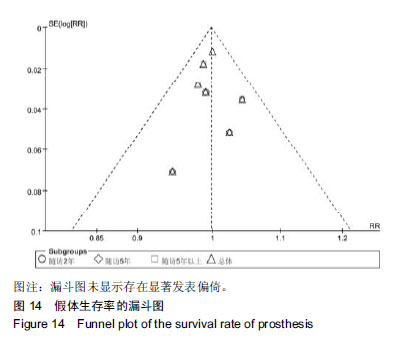Chinese Journal of Tissue Engineering Research ›› 2019, Vol. 23 ›› Issue (24): 3916-3923.doi: 10.3969/j.issn.2095-4344.1301
Previous Articles Next Articles
Treatment efficacy of cementless versus cemented prosthesis in primary total knee arthroplasty: a meta-analysis
- 1School of Clinical Medicine, Ningxia Medical University, Yinchuan 750000, Ningxia Hui Autonomous Region, China; 2Ningxia Medical University, Yinchuan 750000, Ningxia Hui Autonomous Region, China; 3First Department of Orthopedics, General Hospital of Ningxia Medical University, Yinchuan 750000, Ningxia Hui Autonomous Region, China
-
Online:2019-08-28Published:2019-08-28 -
Contact:Chen Desheng, MD, Chief physician, First Department of Orthopedics, General Hospital of Ningxia Medical University, Yinchuan 750000, Ningxia Hui Autonomous Region, China -
About author:Zhao Jiangbo, Master candidate, Physician, School of Clinical Medicine, Ningxia Medical University, Yinchuan 750000, Ningxia Hui Autonomous Region, China -
Supported by:the National Natural Science Foundation of China, No. 81760405 (to CDS), 81760395 (to LY) and 81560364 (to CDS)
CLC Number:
Cite this article
Zhao Jiangbo, Tian Jianing, Li Yan, Chen Desheng.
share this article
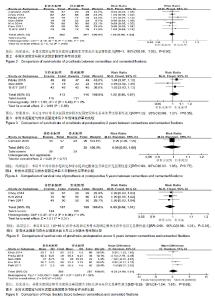
2.3 Meta分析结果 2.3.1 假体生存率 纳入研究中7个研究均报道了假体生存率[11-17]。非骨水泥组382例,骨水泥组361例,共743例。异质性检验结果显示,P=0.78,I2=0%,因此选取固定效应模型进行合并,分析结果显示,非骨水泥固定和骨水泥固定假体生存率差异无显著性意义[RR=1,95%CI(0.98,1.02),P=0.90],见图2。 由于随访时间的长短和假体生存率关系密切,故依据各研究平均随访时间的不同进一步分为3个亚组,分别是短期(2年)、中期(5年)、远期(5-16年)。其中有3个研究平均随访时间为2年[13-14,17],共229例,异质性检验结果显示,P=0.46,I2=0%,因此选取固定效应模型进行合并,分析结果显示,术后2年时非骨水泥固定和骨水泥固定假体生存率差异无显著性意义[RR=1.02,95%CI(0.96,1.07),P=0.55],见图3。有1个研究平均随访时间为5年[11],共86例,分析结果显示,术后5年时非骨水泥固定和骨水泥固定假体生存率差异无显著性意义[RR=0.99,95%CI(0.93,1.05),P=0.77],见图4。有3个研究平均随访时间为5年以上(5-16年)[12,15-16],共346例,异质性检验结果显示,P=0.96,I2=0%,因此选取固定效应模型进行合并,分析结果显示,术后5年以上(5-16年)非骨水泥固定和骨水泥固定假体生存率差异无显著性意义[RR=0.99,95%CI(0.96,1.01),P=0.31],见图5。 2.3.2 美国膝关节协会评分 纳入研究中有5个研究报道了美国膝关节协会评分[12-16]。共567例。异质性检验结果显示,P=0.07,I2=54%,因此选取随机效应模型进行合并,分析结果显示,非骨水泥固定和骨水泥固定美国膝关节协会评分差异无显著性意义[MD=0.28,95%CI(-1.04,1.61),P=0.68],见图6。"
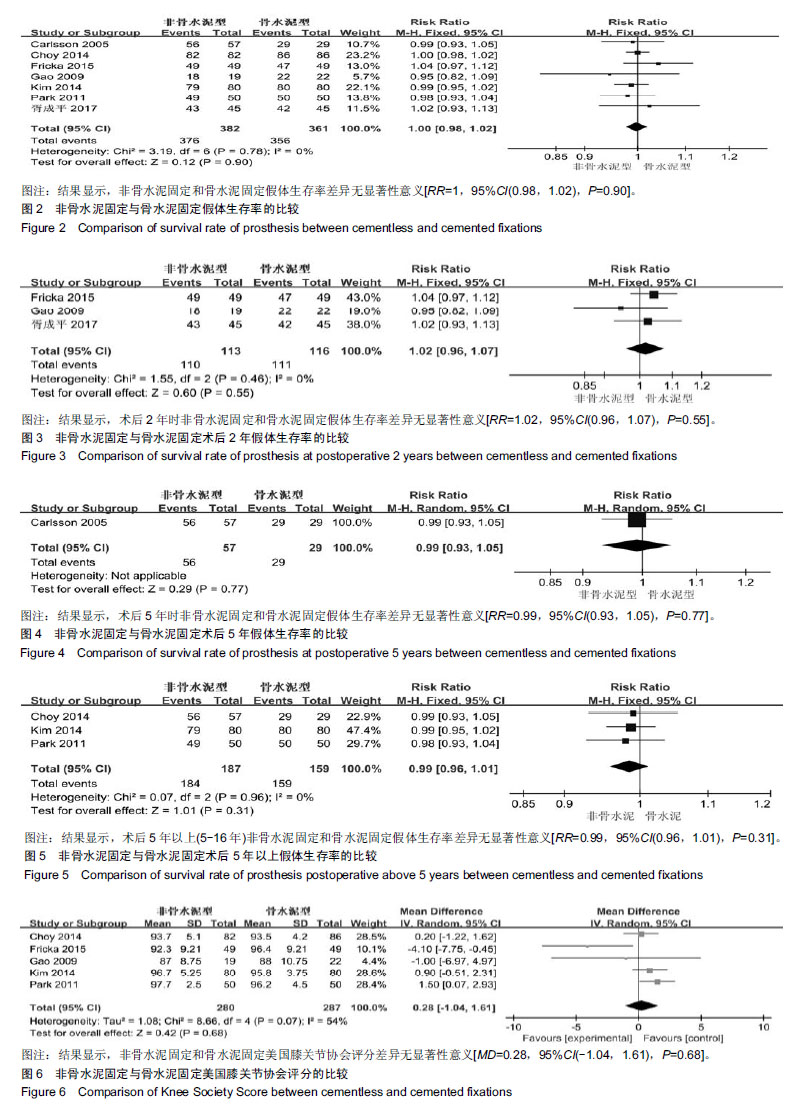
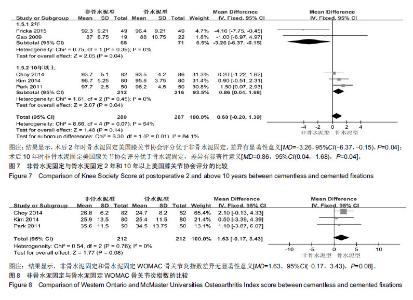
其中有2个研究报道了术后2年时美国膝关节协会评 分[13-14],共139例,异质性检验结果显示,P=0.39,I2=0%,因此选取固定效应模型进行合并,分析结果显示,术后2年时骨水泥固定美国膝关节协会评分优于非骨水泥固定,差异有显著性意义[MD=-3.26,95%CI(-6.37,-0.15),P=0.04],见图7。有3个研究报道了术后10年以上时美国膝关节协会评分[12,15-16],共428例,异质性检验结果显示,P=0.45,I2=0%,因此选取固定效应模型进行合并,分析结果显示,术后10年时非骨水泥固定美国膝关节协会评分优于骨水泥固定,差异有显著性意义[MD=0.86,95%CI (0.04,1.68),P=0.04],见图7。 2.3.3 WOMAC骨关节炎指数 纳入研究中有3个研究报道了WOMAC骨关节炎指数(评价时间为末次随访,平均为10年以上)[12,15-16],共424例,异质性检验结果显示,P=0.76,I2=0%,因此选取固定效应模型进行合并,分析结果显示,非骨水泥固定和骨水泥固定WOMAC骨关节炎指数差异无显著性意义[MD=1.63,95%CI(-0.17,3.43),P=0.08],见图8。"
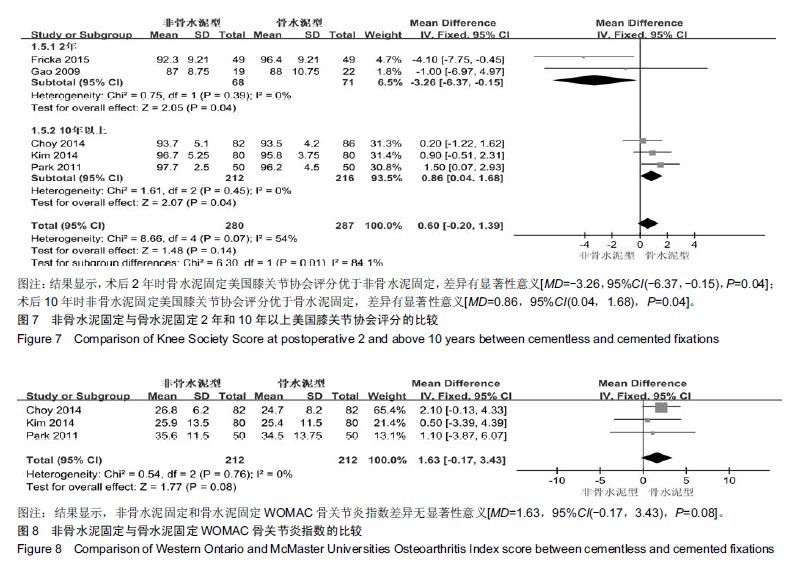
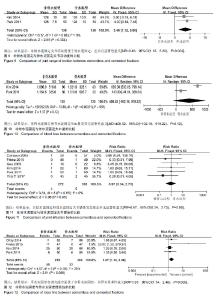
2.3.4 关节活动度 纳入研究中有2个研究报道了关节活动度(评价时间为末次随访,平均为10年以上)[15-16],共260例,异质性检验结果显示,P=0.68,I2=0%,因此选取固定效应模型进行合并,分析结果显示,非骨水泥固定关节活动度优于骨水泥固定,差异有显著性意义[MD=3.46,95%CI(1.12,5.80),P=0.004],见图9。 2.3.5 失血量 纳入研究中有2个研究报道了失血量(术中出血+引流量)[15-16],共260例,异质性检验结果显示,P < 0.000 01,I2=95%,因此选取随机效应模型进行合并,分析结果显示,非骨水泥固定和骨水泥固定失血量差异无显著性意义[MD=408.52,95%CI(-102.18,919.22),P=0.12],见图10。 2.3.6 关节感染 纳入研究中有6个研究报道了关节感染(包括早期感染和迟发感染)[11,13-17],共575例,异质性检验结果显示,P=0.65,I2=0%,因此选取固定效应模型进行合并,分析结果显示,非骨水泥固定和骨水泥固定关节感染发生率差异无显著性意义[RR=0.97,95%CI(0.34,2.73),P=0.95],见图11。 2.3.7 透亮线 纳入研究中有4个研究报道了透亮线(评价标准为1 mm,评价时间2年及2年以上)[12-13,15-16]。共522例。异质性检验结果显示,P=0.18,I2=38%,因此选取固定效应模型进行合并,分析结果显示,骨水泥固定在透亮线方面优于非骨水泥固定,差异有显著性意义[RR=1.67,95%CI(1.14,2.46),P=0.009],见图12。"
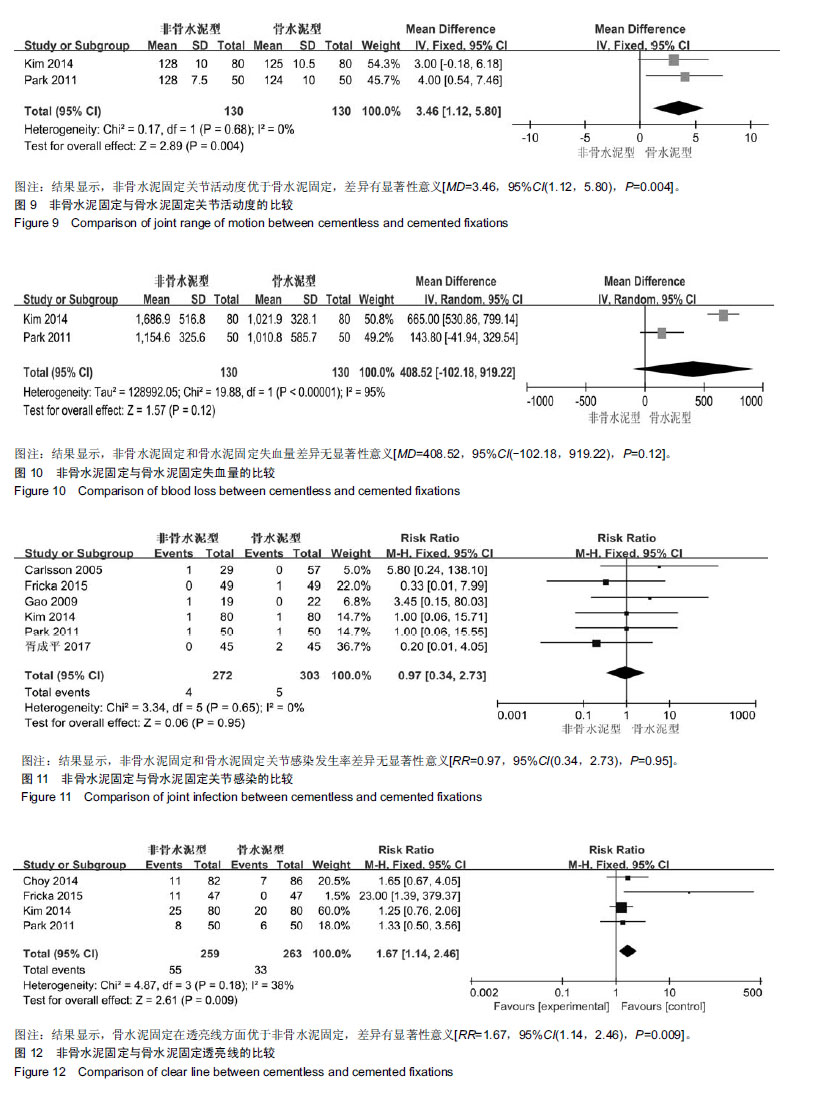
| [1]王韬. 全膝关节置换后关节线变化对髌股关节生物力学的影响[J]. 中国组织工程研究,2016,20(13):1845-1851.[2]Feng J E, Novikov D, Anoushiravani AA, et al. Total knee arthroplasty: improving outcomes with a multidisciplinary approach. J Multidiscip Healthc. 2018;11:63-73.[3]Kurtz SM, Lau E, Ong K, et al. Future young patient demand for primary and revision joint replacement: national projections from 2010 to 2030. Clin Orthop Relat Res. 2009;467(10): 2606-2612.[4]Dalury DF. Cementless total knee arthroplasty: current concepts review. Bone Joint J. 2016;98-B(7):867-873.[5]Abdel MP, Bonadurer GR, Jennings MT, et al. Increased aseptic tibial failures in patients with a BMI ≥35 and well-aligned total knee arthroplasties. J Arthroplasty. 2015; 30(12):2181-2184.[6]Brown TE, Harper BL, Bjorgul K. Comparison of cemented and uncemented fixation in total knee arthroplasty. Orthopedics. 2013;36(5):380-387.[7]Kim YH, Park JW, Lim HM, et al. Cementless and cemented total knee arthroplasty in patients younger than fifty five years. Which is better? Int Orthop. 2014;38(2):297-303.[8]Berger RA, Lyon JH, Jacobs JJ, et al. Problems with cementless total knee arthroplasty at 11 years followup. Clin Orthop Relat Res. 2001;(392):196-207.[9]Dalury DF. Cementless total knee arthroplasty: current concepts review. Bone Joint J. 2016;98-B(7):867-873.[10]Jadad AR, Moore RA, Carroll D, et al. Assessing the quality of reports of randomized clinical trials: is blinding necessary? Control Clin Trials. 1996;17(1):1-12.[11]Carlsson Å, Björkman A, Besjakov J, et al. Cemented tibial component fixation performs better than cementless fixation. Acta Orthopaedica. 2009;76(3):362-369.[12]Choy W, Yang D, Lee K, et al. Cemented versus cementless fixation of a tibial component in lcs mobile-bearing total knee arthroplasty performed by a single surgeon. J Arthroplasty. 2014;29(12):2397-2401.[13]Fricka KB, Sritulanondha S, Mcasey CJ. To cement or not? two-year results of a prospective, randomized study comparing cemented vs. cementless total knee arthroplasty (tka). J Arthroplasty. 2015;30(9):55-58.[14]Gao F, Henricson A, Nilsson KG. Cemented versus uncemented fixation of the femoral component of the NexGen CR total knee replacement in patients younger than 60 years. Knee. 2009;16(3):200-206.[15]Kim Y, Park J, Lim H, et al. Cementless and cemented total knee arthroplasty in patients younger than fifty five years. Which is better? Int Orthop. 2014;38(2):297-303.[16]Park JW, Kim YH. Simultaneous cemented and cementless total knee replacement in the same patients: a prospective comparison of long-term outcomes using an identical design of NexGen prosthesis. J Bone Joint Surg Br. 2011;93(11): 1479-1486.[17]胥成平,向艾力,宋鑫,等. 骨水泥型与非骨水泥型假体的膝关节表面假体置换在治疗骨性关节炎中的疗效[J]. 检验医学与临床, 2017,14(24):3658-3661.[18]Kurtz SM, Lau E, Ong K, et al. Future young patient demand for primary and revision joint replacement: national projections from 2010 to 2030. Clin Orthop Relat Res. 2009;467(10): 2606-2612.[19]Dalury DF. Cementless total knee arthroplasty: current concepts review. Bone Joint J. 2016;98-B(7):867-873.[20]孙孟帅,曹晓瑞,闫昭,等. 非骨水泥型膝关节假体的临床应用进展[J]. 中华骨与关节外科杂志,2018,11(3):233-236.[21]陈跃平,陈亮,高辉,等. 骨水泥与非骨水泥型全膝关节假体置换效果的系统评价[J]. 中国组织工程研究, 2013,17(17):3132-3139.[22]王智勇. 全膝关节置换术中非骨水泥与骨水泥固定型假体的meta分析[D].太原:山西医科大学,2014.[23]Hu B, Chen Y, Zhu H, et al. Cementless porous tantalum monoblock tibia vs cemented modular tibia in primary total knee arthroplasty: a meta-analysis. J Arthroplasty. 2017;32(2): 666-674.[24]Franceschetti E, Torre G, Palumbo A, et al. No difference between cemented and cementless total knee arthroplasty in young patients: a review of the evidence. Knee Surg Sports Traumatol Arthrosc. 2017;25(6):1749-1756.[25]Gerscovich D, Schwing C, Unger A. Long-term results of a porous tantalum monoblock tibia component: clinical and radiographic results at follow-up of 10 years. Arthroplast Today. 2017;3(3):192-196.[26]Niemelainen M, Skytta ET, Remes V, et al. Total knee arthroplasty with an uncemented trabecular metal tibial component: a registry-based analysis. J Arthroplasty. 2014; 29(1):57-60.[27]Defrancesco CJ, Canseco JA, Nelson CL, et al. Uncemented tantalum monoblock tibial fixation for total knee arthroplasty in patients less than 60 years of age: mean 10-year follow-up. J Bone Joint Surg Am. 2018;100(10):865-870.[28]De Martino I, D'Apolito R, Sculco PK, et al. Total knee arthroplasty using cementless porous tantalum monoblock tibial component: a minimum 10-year follow-up. J Arthroplasty. 2016;31(10):2193-2198.[29]Crook PD, Owen JR, Hess SR, et al. Initial stability of cemented vs cementless tibial components under cyclic load. J Arthroplasty. 2017;32(8):2556-2562. |
| [1] | Hu Kai, Qiao Xiaohong, Zhang Yonghong, Wang Dong, Qin Sihe. Treatment of displaced intra-articular calcaneal fractures with cannulated screws and plates: a meta-analysis of 15 randomized controlled trials [J]. Chinese Journal of Tissue Engineering Research, 2021, 25(9): 1465-1470. |
| [2] | Huang Dengcheng, Wang Zhike, Cao Xuewei. Comparison of the short-term efficacy of extracorporeal shock wave therapy for middle-aged and elderly knee osteoarthritis: a meta-analysis [J]. Chinese Journal of Tissue Engineering Research, 2021, 25(9): 1471-1476. |
| [3] | Xu Feng, Kang Hui, Wei Tanjun, Xi Jintao. Biomechanical analysis of different fixation methods of pedicle screws for thoracolumbar fracture [J]. Chinese Journal of Tissue Engineering Research, 2021, 25(9): 1313-1317. |
| [4] | Zhang Tongtong, Wang Zhonghua, Wen Jie, Song Yuxin, Liu Lin. Application of three-dimensional printing model in surgical resection and reconstruction of cervical tumor [J]. Chinese Journal of Tissue Engineering Research, 2021, 25(9): 1335-1339. |
| [5] | Wang Jinjun, Deng Zengfa, Liu Kang, He Zhiyong, Yu Xinping, Liang Jianji, Li Chen, Guo Zhouyang. Hemostatic effect and safety of intravenous drip of tranexamic acid combined with topical application of cocktail containing tranexamic acid in total knee arthroplasty [J]. Chinese Journal of Tissue Engineering Research, 2021, 25(9): 1356-1361. |
| [6] | Xiao Guoqing, Liu Xuanze, Yan Yuhao, Zhong Xihong. Influencing factors of knee flexion limitation after total knee arthroplasty with posterior stabilized prostheses [J]. Chinese Journal of Tissue Engineering Research, 2021, 25(9): 1362-1367. |
| [7] | Zhang Chong, Liu Zhiang, Yao Shuaihui, Gao Junsheng, Jiang Yan, Zhang Lu. Safety and effectiveness of topical application of tranexamic acid to reduce drainage of elderly femoral neck fractures after total hip arthroplasty [J]. Chinese Journal of Tissue Engineering Research, 2021, 25(9): 1381-1386. |
| [8] | Du Xiupeng, Yang Zhaohui. Effect of degree of initial deformity of impacted femoral neck fractures under 65 years of age on femoral neck shortening [J]. Chinese Journal of Tissue Engineering Research, 2021, 25(9): 1410-1416. |
| [9] | Zhang Shangpu, Ju Xiaodong, Song Hengyi, Dong Zhi, Wang Chen, Sun Guodong. Arthroscopic suture bridge technique with suture anchor in the treatment of acromioclavicular dislocation [J]. Chinese Journal of Tissue Engineering Research, 2021, 25(9): 1417-1422. |
| [10] | Liang Yan, Zhao Yongfei, Xu Shuai, Zhu Zhenqi, Wang Kaifeng, Liu Haiying, Mao Keya. Imaging evaluation of short-segment fixation and fusion for degenerative lumbar scoliosis assisted by highly selective nerve root block [J]. Chinese Journal of Tissue Engineering Research, 2021, 25(9): 1423-1427. |
| [11] | Yuan Jiawei, Zhang Haitao, Jie Ke, Cao Houran, Zeng Yirong. Underlying targets and mechanism of Taohong Siwu Decoction in prosthetic joint infection on network pharmacology [J]. Chinese Journal of Tissue Engineering Research, 2021, 25(9): 1428-1433. |
| [12] | Zhou Jihui, Li Xinzhi, Zhou You, Huang Wei, Chen Wenyao. Multiple problems in the selection of implants for patellar fracture [J]. Chinese Journal of Tissue Engineering Research, 2021, 25(9): 1440-1445. |
| [13] | Wang Debin, Bi Zhenggang. Related problems in anatomy mechanics, injury characteristics, fixed repair and three-dimensional technology application for olecranon fracture-dislocations [J]. Chinese Journal of Tissue Engineering Research, 2021, 25(9): 1446-1451. |
| [14] | Chen Junming, Yue Chen, He Peilin, Zhang Juntao, Sun Moyuan, Liu Youwen. Hip arthroplasty versus proximal femoral nail antirotation for intertrochanteric fractures in older adults: a meta-analysis [J]. Chinese Journal of Tissue Engineering Research, 2021, 25(9): 1452-1457. |
| [15] | Chen Jinping, Li Kui, Chen Qian, Guo Haoran, Zhang Yingbo, Wei Peng. Meta-analysis of the efficacy and safety of tranexamic acid in open spinal surgery [J]. Chinese Journal of Tissue Engineering Research, 2021, 25(9): 1458-1464. |
| Viewed | ||||||
|
Full text |
|
|||||
|
Abstract |
|
|||||

